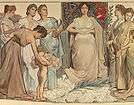Dutch Maiden

The Dutch Maiden (Dutch: Nederlandse Maagd) is a national personification of the Netherlands. She is typically depicted in a Roman garment and with a lion, the Leo Belgicus, by her side. In addition to the symbol of a national maiden, there were also symbolic provincial maidens and town maidens.
Dutch Maiden
A Dutch Maiden has been used as a national symbol since the 16th century.
 Dutch maiden threatened by Spanish soldier. From Gysius: Oorsprong en voortgang, 1616.
Dutch maiden threatened by Spanish soldier. From Gysius: Oorsprong en voortgang, 1616.- Back of 1696 Leeuwarden silver half 3 guilder coin, with the Latin inscription "HANC TUEMUR, HAC NITIMUR" ("We protect her; she supports us"), showing the Dutch Maiden holding a lance topped by a phrygian cap, left hand leaning on a bible and standing on an altar. From the collection of the Teylers Museum
 Flags of the Batavian Republic.
Flags of the Batavian Republic. Dutch Maiden in a political cartoon, entitled "Ons Schibboleth", printed in De Nederlandsche Spectator, 1866.
Dutch Maiden in a political cartoon, entitled "Ons Schibboleth", printed in De Nederlandsche Spectator, 1866. Dutch Maiden atop the national monument at Plein 1813 in The Hague. From a postcard dating around 1890-1905.
Dutch Maiden atop the national monument at Plein 1813 in The Hague. From a postcard dating around 1890-1905. Dutch Maiden on a design for the Golden Coach, by Nicolaas van der Waay.
Dutch Maiden on a design for the Golden Coach, by Nicolaas van der Waay.
During the Dutch Revolt, a maiden representing the United Provinces of the Netherlands became a recurrent theme in allegorical cartoons.
On 25 May 1694, the States of Holland and West Friesland introduced a uniform coin design for the United Provinces, showing a Dutch Maiden leaning on a bible placed on an altar and holding a lance with the Cap of Liberty.[1][2]
During the French occupation, the short-lived Batavian Republic adopted the Dutch Maiden as its main symbol. The symbol was depicted on the upper left corner of the Batavian Republic's flag, with a lion at her feet. In one hand, she holds a shield with the Roman fasces and in the other a lance crowned with the cap of liberty.[3]
The Dutch Maiden continued to be used as a symbol after the foundation of the Kingdom of the Netherlands in 1815. She was integrated into a number of 19th century monuments, including:
- the statue in the centre of Plein 1813 in The Hague,;[4]
- the statue commemorating the Battle of Heiligerlee,[5] and
- the statue on the Nieuwemarkt in Rotterdam.[6]
The theme of the Dutch Maiden still appears now and again. For example, in a political song in his 1977 oudejaarsconference, comedian Wim Kan made a reference to the Dutch Maiden:
- All the geese that lay golden eggs have been slaughtered/
- The Dutch Maiden was raped by the red rooster/
- She was taken to Bloemenhoven/
- On Van Agt's racing bike."
Maiden as a provincial symbol
Starting around the time of the Renaissance, it was not uncommon for a Dutch province to be symbolised by the image of a maiden, e.g. "the Maiden of Holland".
Maiden of Holland
 Maiden of Holland in the garden of Holland, 1563, by Philips Galle
Maiden of Holland in the garden of Holland, 1563, by Philips Galle Same theme appearing 100 years later in 1663, in Adriaen Matham's Counts of Holland series.
Same theme appearing 100 years later in 1663, in Adriaen Matham's Counts of Holland series.
Maiden as a town symbol
A "town maiden" (stedenmaagd) was sometimes used to symbolize a Dutch town, e.g. "the Maiden of Dordrecht".
Maiden of Dordrecht
On a relief on the 16th century Groothoofdspoort in Dordrecht, the Maiden of Dordrecht, holding the heraldic shield of Dordrecht, is seated in the symbolical Garden of Holland. She is surrounded by the heraldic shields of 15 cities. The same theme was the subject of a 1596 gift to the St. Janskerk in Gouda by the Dordrecht city council. From 19 to 23 July 1572, Dordrecht had been the scene of the first independent meeting of the provinces rebelling against Spanish rule.
 Dordrecht Maiden, 1596, stained glass window designed by Gerrit Gerritsz Cuyp in the Janskerk, Gouda.
Dordrecht Maiden, 1596, stained glass window designed by Gerrit Gerritsz Cuyp in the Janskerk, Gouda. Maiden of Dordrecht depicted in the Groothoofdspoort in Dordrecht in 1618.
Maiden of Dordrecht depicted in the Groothoofdspoort in Dordrecht in 1618.
In these symbols of Dordrecht, the heraldic shields are (clockwise from Geertruidenberg, the city shield on the "gate" of the garden) for the following towns: Geertruidenberg, Schoonhoven, Hoorn, Weesp, Leerdam, Naarden, Muiden, Medemblik, Grootebroek, Monnickendam, Enkhuizen, Asperen, Heusden, Schiedam and Vlaardingen.
| Wikimedia Commons has media related to Netherlands Maiden. |
References
- ↑ http://www.muntenmuseum.nl/PDF/Staten%20Generaal%2025%20mei%201694.pdf
- ↑ Hubert de Vries, Wapens van de Nederlanden. De historische ontwikkeling van de heraldische symbolen van Nederland, België, hun provincies en Luxemburg. Uitgeverij Jan Mets, Amsterdam, 1995, page 183, note 9.
- ↑ Hubert de Vries, Wapens van de Nederlanden. De historische ontwikkeling van de heraldische symbolen van Nederland, België, hun provincies en Luxemburg. Uitgeverij Jan Mets, Amsterdam, 1995, page 38-39.
- ↑ http://www.vanderkrogt.net/standbeelden/object.php?record=ZH15bg
- ↑ http://www.vanderkrogt.net/standbeelden/object.php?record=GR23cb
- ↑ http://www.vanderkrogt.net/standbeelden/object.php?record=ZH58cf